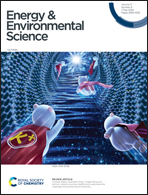Regulating electrode/electrolyte interfacial chemistry enables 4.6 V ultra-stable fast charging of commercial LiCoO2†
Abstract
The difficulty of achieving fast-charging high-voltage lithium-ion batteries arises from severely unstable electrode–electrolyte interfaces with sluggish kinetics. Here we overcome this challenge by developing a “cocktail electrolyte” enabling commercial LiCoO2 with ultra-stable fast-charging in a wide-temperature range. Unlike commercial carbonate electrolytes, our electrolyte synergistically contributes to fast ion transport and robust electrode/electrolyte interphases, which suppresses interfacial side reactions, accelerates interfacial reaction kinetics on the cathode side, and prevents Li-dendrites on anodes even at extremely high-rates (3C and 5C). Consequently, the Li||LiCoO2 coin cell displays ultra-high stability both at a fast-charging rate (5C, 73.2% retention after 1000 cycles) and under extreme conditions (−20 and 45 °C), far beyond the state-of-the-art electrolytes. Moreover, we show the practical and general applicability of our electrolyte through the stable operation of a graphite||LiCoO2 pouch cell (72.1% retention after 2000 cycles) and other advanced high-Ni or Co-free cathodes. This work proposes deep insights and a practical strategy for high-energy-density and fast-charging batteries.

- This article is part of the themed collection: Recent Open Access Articles


 Please wait while we load your content...
Please wait while we load your content...